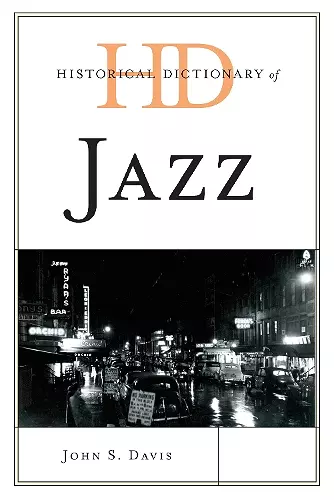Historical Dictionary of Jazz
Format:Hardback
Publisher:Scarecrow Press
Published:13th Sep '12
Currently unavailable, and unfortunately no date known when it will be back

Jazz is a music formed from a combination of influences. In its infancy, jazz was a melting pot of military brass bands, work songs and field hollers of the United States slaves during the 19th century, European harmonies and forms, and the rhythms of Africa and the Caribbean. Later, the blues and the influence of Spanish and French Creoles with European classical training nudged jazz further along in its development. Jazz has always been a world-music in the sense that music from around the globe has been embraced and incorporated. The Historical Dictionary of Jazz covers the history of Jazz through a chronology, an introductory essay, and an extensive bibliography. The dictionary section has over 1,500 cross-referenced entries on significant jazz performers, band leaders, bands, venues, record labels, recordings, and the different styles of jazz. This book is an excellent access point for students, researchers, and anyone seeking a broader understanding of the history of jazz and the connections within the genre.
In compiling this useful research tool, Davis (Univ. of Colorado, Boulder) draws on a deep knowledge of jazz. The 1,500-plus entries include important musicians, terms, places, and events. While terms such as "Blues" and "Bebop" are afforded short entries, "Jazz" does not appear in the dictionary proper. Instead, Davis provides a brief but informative introductory essay outlining the origins and history of jazz. Typical entries are short, highlighting careers of various figures, discussing the importance of places and events, and offering general descriptions of concepts. Longer entries, such as "Armstrong, Louis," can run several paragraphs, detailing performances, contributions, and influence. Content spans the gamut of jazz from its early influences in blues and popular entertainment to its contemporary manifestations. The work commences with a chronology starting with jazz's vaudeville roots in 1881 and ending with milestones through 2011. Davis caps off the dictionary with a short bibliographic essay and a useful bibliography arranged by subgenres and artists, including general works. Cross-referencing is done via boldface type and see also indications. The author draws on a rich background as trumpeter, conductor, and university teacher. Summing Up: Recommended. Lower-level undergraduates, practitioners, and general readers. * CHOICE *
With more than 1,500 brief, alphabetically arranged, and cross-referenced entries, this book covers everything from slave songs to brass bands to contemporary jazz. Also featured are the influences of Afro-Caribbean rhythms, European classical music, and the Mississippi blues. Entries are devoted to influential performers and bandleaders, noteworthy venues, seminal recordings, popular record labels, and various jazz styles—bebop, swing, etc. The volume begins with a chronology starting in 1881, is followed by an introductory essay, and ends with an extensive bibliography. Recommended for most library collections. * Booklist *
This book would be better suited to a circulating rather than a reference collection. * American Reference Books Annual *
[T]his is a solid,. . . worthy reference book, with basic information of a wide variety of topics. It is up to date. The bibliography is substantial. * s *
ISBN: 9780810867574
Dimensions: 236mm x 159mm x 40mm
Weight: 848g
470 pages